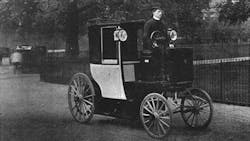London’s iconic black cabs are banking their future on a 19th-century technology: the electric motor.
To help solve the U.K. capital’s smog problems, London Taxi Co. is turning to methods of propulsion used by forerunners at the London Electrical Cab Co., which from 1897 ran a fleet of 80 battery-powered cars designed by Walter C. Bersey. That first electric-motor taxi trial fizzled out in 1899 after the costly vehicles, which drove only slightly faster than a horse, were scrapped for internal-combustion engines powered by gas.
Fast forward almost 120 years and Peter Johansen, president of London Taxi Co., is going back in time to boost U.K. manufacturing and bring better air quality to the city’s streets. His company’s investing $400 million to build electric cabs. The transition away from all diesel vehicles driving in London could help eliminate almost 10,000 early deaths a year caused by smog.
“There’s a general recognition of the need to improve air quality,” Johansen said in a telephone interview. “Clearly, electric vehicles are the way of the future for urban situations.”
The new London Taxi Co. factory near Coventry will start stamping out electric cabs from 2018, the date when all new taxis on London’s streets need to be zero-emissions capable, with either pure electric or hybrid motors. The company, owned by China’s Geely Automobile Holdings group, this year toured European cities from Paris to Berlin, seeking to drum up interest for a potential export market, said Johansen, adding that the June 23 vote to leave the European Union hasn’t impacted his company.
Efforts to improve air quality across the EU have been hindered by automakers’ decision to push diesel-fueled car models. While those vehicles emit less carbon dioxide than gasoline cars, they spew more nitrogen dioxide, which the European Environment Agency blames for increased respiratory conditions and cardiovascular disease. Volkswagen AG’s scandal over U.S. emissions helped raise awareness about diesel’s health impacts.
London Mayor Sadiq Khan campaigned this year on cleaning up his city’s air and wants to tighten U.K. pollution laws. Among his first acts in office were to crack down on London’s diesel fleet and call on the government to refresh its 60-year-old Clean Air Act, which was passed following the great London smogs that choked the city in the 1950s.
Taxis could benefit from Khan’s proposal to pay drivers to scrap diesel cars, Johansen said. Without switching to electric motors, London’s 23,000 diesel-powered taxis are expected to spew about a fifth of central London’s nitrogen oxide emissions in 2020, according to the mayor’s office.
London Taxi is still trying to determine how much its electric cabs will cost and expects falling battery prices in the next 18 months to make their vehicle more attractive, Johansen said. Battery storage could fall by as much as 52%, to $182 per kilowatt hour, by 2025, according Bloomberg New Energy Finance, which predicts 35% of new car sales globally will be electric by 2040.
“The battery is about one-third of the cost of a vehicle, so there’s no point in announcing a price today because it’s all academic,” he says.
Cost will nevertheless be one of the biggest concerns for taxi drivers, already under pressure from the rise of Uber, which offers London’s commuters and tourists significantly cheaper fares.
“In the long run the government will have to subsidize us,” said John Nicholson, 56, who’s driven London taxis for 32 years.
Speaking in an interview from his TX4 diesel-fueled cab, Nicholson added he’s concerned about the city’s lack of charging points along with vandals who’d “probably cut the wires” when he tried plugging in at home.
The city of London will also need to follow-up on commitments encouraging the switch to electric vehicles, according to Johansen. The capital has installed just 3% of the 25,000 charging points that former Mayor Boris Johnson promised would be in place by 2015, according to Bollore SA which operates the network.
“We are looking at how we can provide that on a commercial basis with other business partners,” said Johansen. “We will need a number of hubs in and around London that are for rapid charging, so that a taxi driver typically can top up when he’s having a tea break.”
London Taxi’s new electric car will face many of the same challenges as Bersey’s original 1897 model. Beyond just the challenge of building out a charging network, electric cars will still have to compete with gasoline, he said.
“The reasons why electric vehicles weren’t successful then,” Johansen said, “are also the obstacles that we come up against.”
By Jessica Shankleman, with assistance from Ania Nussbaum
About the Author
Bloomberg
Licensed content from Bloomberg, copyright 2016.
